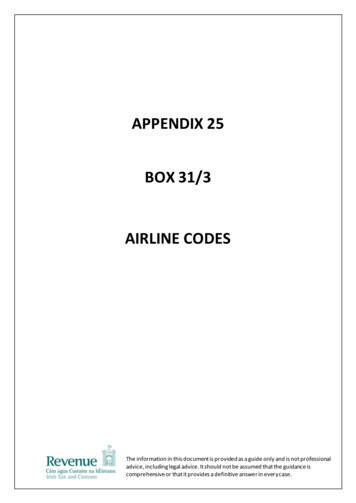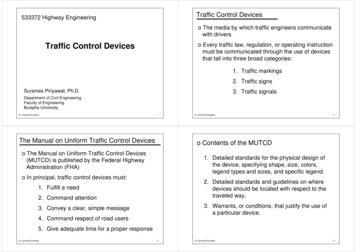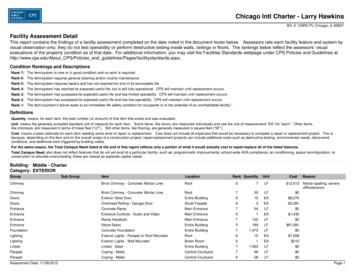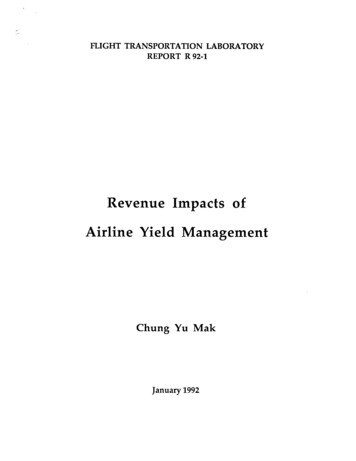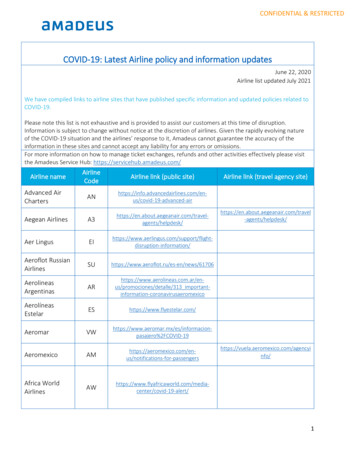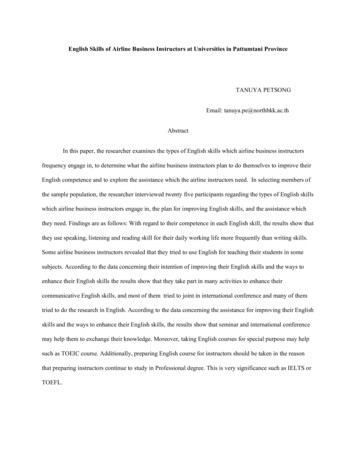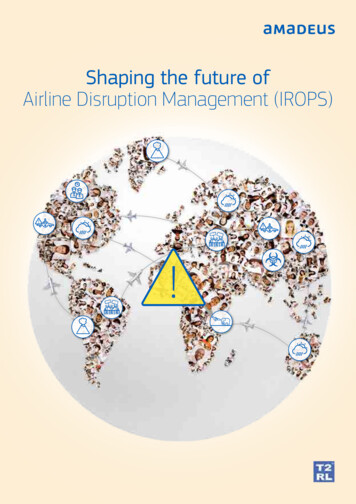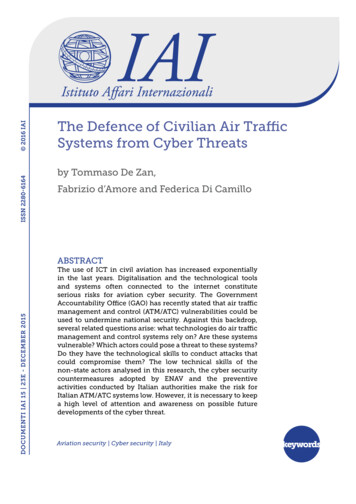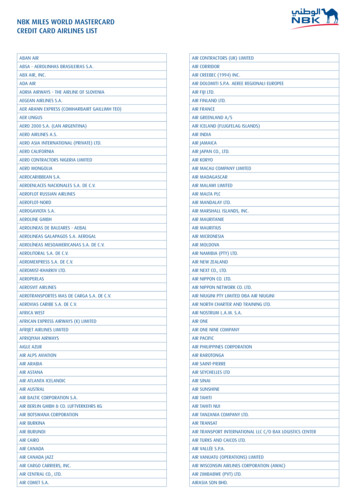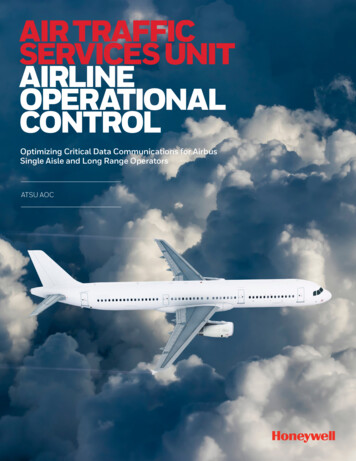
Transcription
AIR TRAFFICSERVICES UNITAIRLINEOPERATIONALCONTROLOptimizing Critical Data Communications for AirbusSingle Aisle and Long Range OperatorsATSU AOC
AIR TRAFFICSERVICES UNITAIRLINE OPERATIONALCONTROL (ATSU AOC)Optimizing Critical Data Communications for AirbusSingle Aisle and Long Range OperatorsThe Air Traffic Services Unit (ATSU)provides the Datalink Host Platform,Router and Air Traffic Controlapplications used for Datalinkcommunications on the AirbusA318, A319, A320, A321, A330 andA340 aircraft. The Honeywell ATSUAirline Operational Control (AOC)software and database supportoperational functions including:Honeywell’s ATSU AOC softwarefunctionality is configured within auser-modifiable AOC Database. TheAOC Database can be tailored directly byHoneywell customers using the ACARSReconfiguration Tool or by the HoneywellDatalink Services team. AOC Databasesare loadable on-wing and do not requireaircraft certification (TC or STC). Threecomponents make up the ATSU system: AOC uplinks and downlinks thatenable efficient airline operations The ATSU Hardware on Airbusplatforms – provided by Airbus Out-off-on-in (OOOI) logic todefine each flight phase The ATSU Aircraft Interface Software(including air/ground Router) andATC Application - provided by Airbus AOC user interface to the flight crew Aircraft and operational datareporting—including engine, fuel,avionics and maintenance reportsThis brochure outlines the majorfunctions provided in Honeywell ATSUAOC software, with particular emphasison the AOC Enhancements introducedin the latest software version (partnumber 998-2459-513) that enableairline operational cost savings andfacilitate schedule integrity. ATSU AOC-513 software became the standardversion for forward-fit SA/LR aircraftdeliveries in 2019. ATSU AOC -513software is also available for retrofit. The ATSU AOC software and AOCDatabase – provided by Honeywell1 www.aerospace.honeywell.com Honeywell Air Traffic Services Unit Airline Operational Control
ATSU AOC ENHANCEMENTS FOR REDUCEDAIRLINE OPERATIONAL COSTSThe data fees an operator pays to communication service providers, such as ARINC, SITA, AVICOM, and ADCC can besubstantial. The ATSU AOC provides options within its Airline Operational Control Database to minimize these data costs.FOMAX/AoIP(available at select airports)InternetSATCOMVHFCommunicationService ProviderHFAirline DataCenterSET MESSAGE ROUTING PRIORITIES TO DESIGNATE MESSAGETRANSMISSION ON THE LEAST EXPENSIVE NETWORK LINK.Network routing choices now include: AOIP preferred VHF preferred SATCOM preferred HF preferred VHF only SATCOM onlyPriorities may be set for internalAOC Messages (e.g. OOOI, FreeText) and external AOC Messages(e.g. Maintenance Reports fromCMC or Engine Reports fromACMS). The available data link withthe lowest cost will be used forthese non-safety messages.Aircraft equipped withthe Airbus FOMAX AoIPcapability can send AOCmessages using ACARS overInternet Protocol (AoIP).The lower cost AoIP link can be usedfor larger messages. More data canbe cost-effectively sent to AirlineComputing Systems for analytics. HF onlyHoneywell Air Traffic Services Unit Airline Operational Control www.aerospace.honeywell.com 2
1. HOW ATSU AOC ENABLESOPERATIONAL EFFICIENCYHoneywell ATSU AOC provides enhanced ACARS customization via auser-modifiable Airline Operational Control (AOC) database that:Database-defined logicAOC Database Provides air-ground data reporting that is critical to bigfleet services and operational efficiency Defines the flight crew interface for ACARS, flight information,and metric reportingExamples of information: Operations data Enables collection of “big data” for offline analytics that canbe used to understand and improve fuel efficiency, fleetoperations, turn-around time, and aircraft maintenance Fuel data AOC communications Aircraft PositionGATHER AIRCRAFTINFORMATION AND GENERATEAUTOMATIC REPORTSOPTIMIZE FUEL EFFICIENCYAND ENABLE FURTHERFUEL-SAVING ANALYTICS Precise time the passenger, cargo,and catering doors open or close Fuel on-board and fuel burned(calculated using fuel flow data).This data can be reported for flightsegments like taxi out, takeoff hold,climb, cruise, diversion, descent,taxi in, hold for gate and at endof flight. Data supports analysisof fuel usage and identificationof fuel saving opportunities Parking brake set/release times Engine start and stop times Movement times, includingpush-back, start of taxi, takeoff,landing and gate arrival Flight phase times, includingtop of climb, top of descentand start of approach Crew requests for ground services,including gate assignment,maintenance, connecting gateinformation and passenger services APU start/shutdown events Refueling information, includingfuel quantity before and afterrefueling, billing information andchecks to ensure that adequatefuel has been loaded Turn-around times—after doors closehow long before start of taxi; after taxiin how long before passenger doorsopen; after galley door opened howlong for catering operation to complete;after cargo door opened how longfor baggage loading to completePROVIDE THE FLIGHT CREWWITH THE RIGHT INFORMATIONAT THE RIGHT TIME Aircraft position reports,including abnormal positionreporting every minute, shouldan emergency situation occur Remind crew to perform neededactions, including sending a groundrequest if not already sent Collect other data at each flightevent; for example: engine power, fuelonboard, fuel burned, altitude, heading,air speed, ground speed and roll angle In-range reports, request forground services, uplink gateassignments, uplink connectinggate information for passengersFLIGHT TRACKING TOMEET ICAO GADSSRECOMMENDATIONSFOR INITIAL PHASEThe ATSU AOC will monitor aircraftmovement and operational parametersto determine an urgent or emergencysituation, then automaticallysend aircraft position reports with1-minute intervals with the relevantaircraft information to the airlineoperations center. The airline canthen initiate secondary actions andrespond to the situation. Criteriaused to detect abnormal eventsare tailorable and can include: Altitude outside a safe range Ground/Air Speed outside a safe range Fuel on Board too low Vertical Speed for descentor climb is not safe Go around Loss of cabin pressure Engine power is too low Send Advisory Uplinks to the aircraftto notify the flight crew of an urgentmessage/task. The MCDU pagescan be tailored to provide the flightcrew with prompted responsechoices (Accept/Reject/Respond)3 www.aerospace.honeywell.com Honeywell Air Traffic Services Unit Airline Operational Control
2. ATSU AOC -513 SOFTWARE OVERVIEWHoneywell first introduced the ATSU AOC in 1999 and has made several software updates since. The most recent software version,designated “-513 software” and released in 2018, includes AOC Enhancements specifically requested by Honeywell airlinecustomers. The AOC Enhancements enable operational cost savings, increase the tailorability of ACARS/AOC messages, andenable commonization of AOC functionality across CMU MKII and ATSU platforms for airlines with mixed Boeing and Airbus fleets.AOC ENHANCEMENTS INTRODUCED IN ATSU AOC -513 SOFTWAREAdded access to 1,000 new AOC parametersEnables operating cost savings through intelligent use of aircraft dataAdded ACARS Over IP support per Airbus Std 9 * Enables non-safety messages to be sent over an Internet Protocol linkAdded complex logic units, triggered actions,and enhanced parameter useEnables if/then and event-based reporting, equalizes ATSU logic capabilitywith CMU MKII , copy right to left, multiply and divide, nested if/thenfunctions, increased selection lists, increased print/display formats,increased table sizesAdded key-based complex logicEnables MCDU keys to initiate nested and compound logic functionsAdded option for multiplication and divisionIncreases math functions beyond addition and subtractionAdded routing preferences for peripheralavionics and AOC messagesAble to define routing preferences for all messages (except ATC/FANS). Forexample: specify HF or Satcom preferred. Enables retrofit with equipmenton HF or SATCOM ports that uses IP for routingAdded bell character audio chimeEnables additional method to notify pilot of uplink messageAdded option for pilot to confirm messagedeletionProvides sanity check before deleting messagesAdded OOOI support for A321-ACF passengerloading doorsAutomatically detects passenger door configuration on Cabin Flex aircraft.Correct set of doors is used in the Out-Off-On-In logicAdded RESPOND action for uplinked reportsWhen received message is displayed, it can be defined to include aRESPOND prompt. The RESPOND key is defined to display any databasedefined pageHISTORICAL ATSU AOC SOFTWARE 59-513(2018)Configurable with AOC DatabaseXXXMeteorological Weather Reporting – Version 2XXXActive AdvisoriesXXConditional Logic (IF, ELSEIF, ELSE) for Line Select KeysXXLogic Units with Complex and Compound StatementsXRouting Policy for LRUs Defined in AOC DatabaseXAOIP, HF, and SATCOM Preferred Routing PoliciesPre-FANS – Standard AOCXXFANS , FANS A , FANS B/B – Standard AOCFANS A B – Standard AOCXXXXHoneywell Air Traffic Services Unit Airline Operational Control www.aerospace.honeywell.com 4
3. ATSU AOC -513 SOFTWARE USE CASES AND EXAMPLESATSU AOC -513 software enables a much greater level of customization than previous ATSU AOC software versions. Thecustomization capability for the ATSU AOC is now equivalent to that of the CMU MKII used on the Boeing 737 and otheraircraft, which enables fleet commonization for airlines with both Airbus and Boeing aircraft. The structure of the AOCdatabase is now very similar, including the number of parameters, table sizes and database logic functions. It is possibleto convert CMU MKII databases into ATSU AOC v25.0 databases and vice versa. This enables airlines to easily maintainAOC Applications that are similar in functionality and their crew interface for both Airbus and Boeing aircraft.3.1 INCREASED AOCDATABASE CAPACITY FORRECONFIGURATION – ADDED1000 PARAMETERSATSU AOC -513 software enables useof 1,000 new AOC parameters to relievedatabase size constraints for airlineswith large, complex AOC databases. Inaddition, many AOC Database tableshave been increased to enable definitionof more downlinks, uplinks, screens andactions (logic). The new parameters andtable entries can enable operational costsavings, by monitoring and collectingdata, so it can be reported whencertain conditions are met, or savedand sent in one summary message.phases, store fuel burned for differentflight stages and collect refuelingdata. This information can be usedby fuel efficiency systems (or otherground-based analytics) that helpairlines achieve fuel cost savings.Parameters can be used to gatherperformance data and fuel usage.Additional usage examples include: Parameters can be used to collectdata to help identify opportunities forimprovements to shorten turnaroundtimes. For example, upon takeoff, storepassenger door close time, cargo doorclose times, time until push-back, timeduring return to gate, time until start oftaxi, time during taxi, time until take-off,when engines are running and delayinformation (time and reason). Uponlanding, collect landing, taxi, parkingbrake, time airplane stops moving,engine shut down, time until passengerdoor opens and cargo door opening. Parameters can be used to captureAPU start/shutdown events, enginestart and stop times, detect whentaxi is done using a single engine,store fuel-on-board at different flight Parameters can be used to collectsnapshots of the aircraft and flightcrew performance. For example, duringtakeoff rolling out and when groundspeed is 80knots, report the EngineN2 power, or during approaching, reportroll angle at multiple desired altitudesand CAS. The data can be stored forthe flight crew to review immediatelyafter landing or the data can beadded to the AOC landing report.3.2 ATSU AOC MESSAGESSENT OVER AOIPATSU AOC -513 software enablesaircraft equipped with the Airbus FOMAXACARS Over Internet Protocol (AoIP)capability to send ATSU AOC messagesover the low-cost FOMAX AoIP system.The lower cost AoIP link can be usedfor larger messages, such as engineand maintenance reports that supportground-based analytics. In addition,selected ATSU AOC messages may alsobe designated to be sent over AoIP.Contact your Airbus CustomerEngineering Representativefor details about FOMAXavailability on SA/LR aircraft.5 www.aerospace.honeywell.com Honeywell Air Traffic Services Unit Airline Operational Control
3.3 ATSU AOC DATABASELOGIC UNITS ANDTRIGGERED ACTIONSFlight Summary will be automaticallysent. Example logic for SEND LSK:ATSU AOC -513 software introduceslogic units and triggered actions. Prior to-513, logic such as IF, ELSEIF, ELSE andtriggered actions can be performed whenan MCDU Line Select Key is pressed.For example, when a SEND prompt ispressed, a simple test of a conditioncan be done before actions are taken:IF airplane is IN at the gatedownlink the Post Flight SummaryELSEdisplay a message in the scratchpad “NOTALLOWED UNTIL IN”.ENDIFWith -513, now it is possible to definecompound and nested logic that willbe performed when an MCDU LineSelect Key is pressed (referred toas LSK Actions), when a predefinedevent occurs (Triggered Actions), and/or once per second (Logic Units).The simple logic above can beextended to check for the IN statewhen Post Flight Summary SEND keyis pressed. If not IN yet, set a flag,so when the airplane goes IN, the PostIF airplane is IN at the gatedownlink the Post Flight SummaryELSECopy ‘1’ to the Send Post Flt flagENDIFTriggered action assigned to IN trigger:IF Send Post Flt Flag “1”downlink the Post Flight SummaryCopy ‘0’ to the Send Post Flt flagENDIFAnother example of logic unit use for theON flight phase is provided here. Aftertouchdown, detect when the airplanestops moving before the first door opens:IF OOOI state is ON and ground speedis 3 knotsSave ground speed value and UTC every10 seconds (expands to more logic)Compare the current ground speed tothe values saved 10, 20 and 30 secondsearlier (expands to more logic)IF ground speed has changed less than.20 knots for the last 30 secondsCopy the UTC from 30 seconds ago tothe parameter used to store the time theairplane stopped movingENDIFAnother example of logic unit use forAbnormal Position Reporting purposesis provided here. In this example, wewant to detect if the aircraft altitudedrops below 10,000 feet during thecruise phase (10 minutes after takeoffand 15 minutes before landing) andthen kick off Abnormal Aircraft PositionReports with 1 minute intervals (perthe ICAO GADSS recommendations).Use a logic unit that willexecute once per second.IF OOOI state is OFFCalculate time since OFF Current UTC –OFF timeCalculate time to destination ETA –Current UTCIF time since OFF 10 minutes ANDtime to destination 15 minutesIF altitude 10,000Copy 1 minute to position reportintervalSend position report and restartintervalENDIFENDIFENDIFThis logic defined in the ATSU AOCdatabase can be documented withcomments to improve maintainability.See below for an example.Honeywell Air Traffic Services Unit Airline Operational Control www.aerospace.honeywell.com 6
3.4 ATSU AOC MEDIA SELECTION AND ROUTING PREFERENCESATSU AOC -513 software enables the definition of Message Routing Preferences that allow airlines to send ACARS messagesover the lowest cost link. There are two places in the ATSU AOC database where it is possible to select the media and routingpreferences for AOC messages. Each AOC message defined in the AOC Database may be assigned the media that will be used.The choices include VHF only, SATCOM only, HF only, or Media ‘G’. The default policy for ‘G’ is defined as VHF preferred. Thisis also where AoIP may be selected as the preferred media and will be used when the airplane is equipped with FOMAX.The routing policy for Media ‘G’ and VHF only (Media ‘V’) may be further customized in the Routing Policy Table of the database.This table allows the ATSU AOC database to specify the preferred routing media for internal ATSU AOC messages and for peripheralAOC messages generated by end-systems connected to the ATSU—including FMS, CFDIU, ACMS/DMU, and Cabin Terminals.7 www.aerospace.honeywell.com Honeywell Air Traffic Services Unit Airline Operational Control
The use of this feature, when coupled with ACARS data link services through Chinese telecommunications company Avitech,has allowed Airlines in China to reduce their airline data costs for ACARS traffic by up to 90%. Chinese airlines pay Aviation DataCommunication Corporation (ADCC) for ACARS traffic. A new China Telecom, called Avitech, now provides data link servicevia Iridium SATCOM and offers a competitive price for traditional ACARS traffic that can be 90% less costly than ADCC.The downlink media preference can be set as Iridium preferred, while still allowing the ATSU to send downlinks viaVHF or HF, when Iridium is in “No Communication” status. The routing preferences set in the ATSU AOC Databasemake the Media G field for the individual peripheral end-systems set to SATCOM Preferred. This will cause the IridiumSATCOM to be used as the primary choice. The setting shown below is done for CMC and ACMS messages.For ATSU AOC messages, it is necessary to keep the default routing policy for Media G as “VHF, SATCOM, HF”. This is necessary toensure that ARINC 623 messages (D-ATIS, OCX, and DCL) are sent via VHF. The A623 messages are defined to use the Media Gmedia. For Chinese airlines that want the database defined ATSU AOC (non-safety) messages to be sent using the Iridium SATCOM,the Media field should be specified as SATCOM Only, so the Iridium SATCOM will be used to send the non-safety AOC Message.Honeywell Air Traffic Services Unit Airline Operational Control www.aerospace.honeywell.com 8
3.5 ACCESS TO RESPOND SCREENS FROM THE RECEIVED MESSAGE DISPLAY PAGEThe -513 ATSU AOC adds the ability to define an uplinked Report so the flight crew can easily view and respond. A prompt can bedefined to display any database-defined screen. The screen can be defined so the crew can enter data before sending a responseto the uplink. This is useful for responding to free-text uplinks with a free-text downlink or for entering a reason for rejection.This simplifies the Crew Interface.For example, when RESPOND is pressed, the AOC RESPOND page is displayed on the MCDU. Refer to below MCDU screen examples.In this next example, the REJECT key will cause a screen to be displayed where the reason for rejection can be entered. TheACCEPT key can be defined to display a different screen, or to simply send the ACCEPT message.3.6 OPTION TO REQUIRE CONFIRMATION BEFORE DELETING UPLINKED MESSAGESWhen the Enable Message Delete Confirm option is selected in ATSU AOC -513 software, it protects the crew from mistakenlydeleting messages from the Received Messages list. This improves the flight crew interface.9 www.aerospace.honeywell.com Honeywell Air Traffic Services Unit Airline Operational Control
When the Clear Key is pressed and then the key next to the message is pressed, the AOC DELETE MSG screen presentsthe choice to Cancel or Confirm the deletion. The CONFIRM key must be pressed before the message will be deleted.4. ATSU AOC SOFTWARE AVAILABILITY AND ORDERING INFORMATIONATSU AOC -513 software replaces all previous software versions. The software is additive—all functionality remains fromprevious versions. ATSU AOC -513 software has been tested and approved by Airbus and is available for retrofit andforward-fit applications today.STSU AOC SOFTWAREOrderable Part NumberDescriptionService Information Letter998-2459-513ATSU AOC -513 Software,Electronic Download – files for loadingusing A615-3 or A615-A Data LoadingD20181000003969002375-513ATSU AOC -513 Software,Electronic Download – files for loadingusing A665 Data LoadingD201810000039SWM998-2459-513ATSU AOC -513 Software,Floppy Diskette Installation Media –A615D201810000039SWM69002375-513ATSU AOC -513 Software,CD-ROM Installation Media – A665D201810000039Electronic software download can be made available from https://ads.honeywell.com. Contact your Honeywell Sales Manager forelectronic download ordering details and support.ATSU AOC software can be installed on the ATSU using the ARINC 615-3 or ARINC 615-A method (when ordering specify partnumber 998-2459-513) or using the ARINC 665 method (when ordering specify part number 69002375-513). Software loadinginstructions are contained within the Service Information Letter.5. DATALINK SERVICESThe Honeywell Datalink Services team is a core group of experts that collaborate directly with Honeywell customers to tailorATSU AOC capabilities to your specific operational requirements. The Datalink Services team can take the complexity out ofACARS customization by listening to your operational needs, developing a custom AOC database suited to your specificationsand finally simulating and testing the database functionality before the AOC database is deployed to your fleet. This is often aless-costly and more-conclusive test methodology than removing aircraft from revenue flights to verify new AOC databasefunctionality. AOC database customization is accomplished using Honeywell proprietary ground-based support tools includingthe ACARS Reconfiguration Tool (ART ) and Airsim . For further database customization support please contactDatalinkServices@Honeywell.com.Honeywell Air Traffic Services Unit Airline Operational Control www.aerospace.honeywell.com 10
More information about Honeywell’s ATSUAOC capabilities can be found online ommunicationFurther ATSU AOC -513 softwareordering information is available fromyour Honeywell Sales Manager and at:myaerospace.honeywell.comFor 24/7 technical support for all yourHoneywell Aerospace products contact:AeroTechSupport@Honeywell.comHoneywell Aerospace1944 E Sky Harbor CirclePhoenix, AZ 85034aerospace.honeywell.comN61-2460-000-000 04/20 2020 Honeywell International Inc.
1000 PARAMETERS ATSU AOC -513 software enables use of 1,000 new AOC parameters to relieve database size constraints for airlines with large, complex AOC databases. In addition, many AOC Database tables have been increased to enable definition of more downlinks, uplinks, screens and actions (logic). The new parameters and
